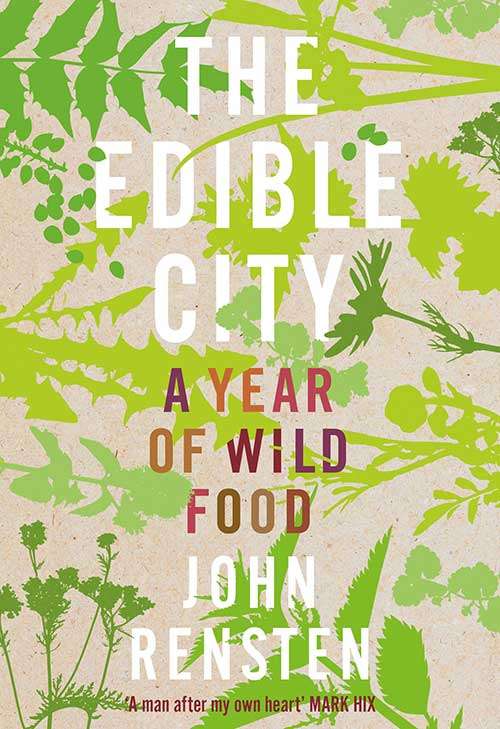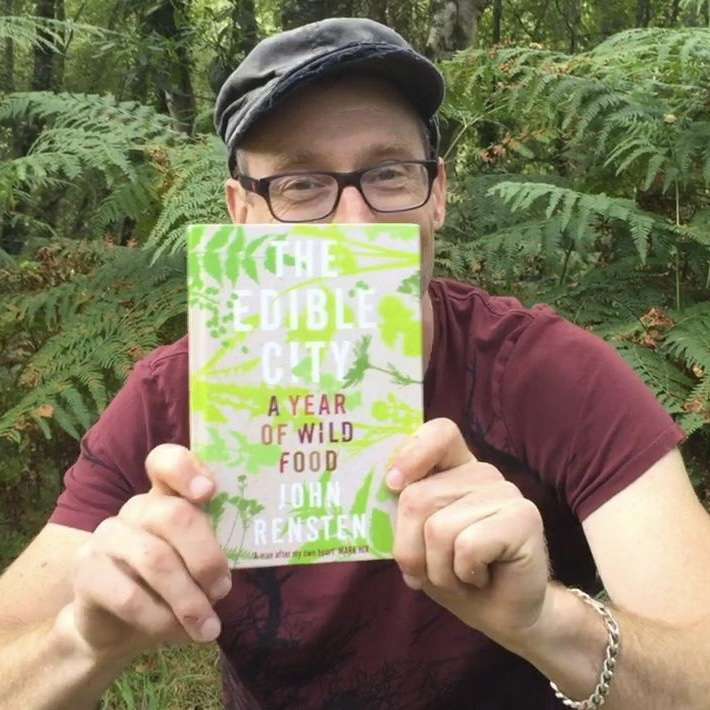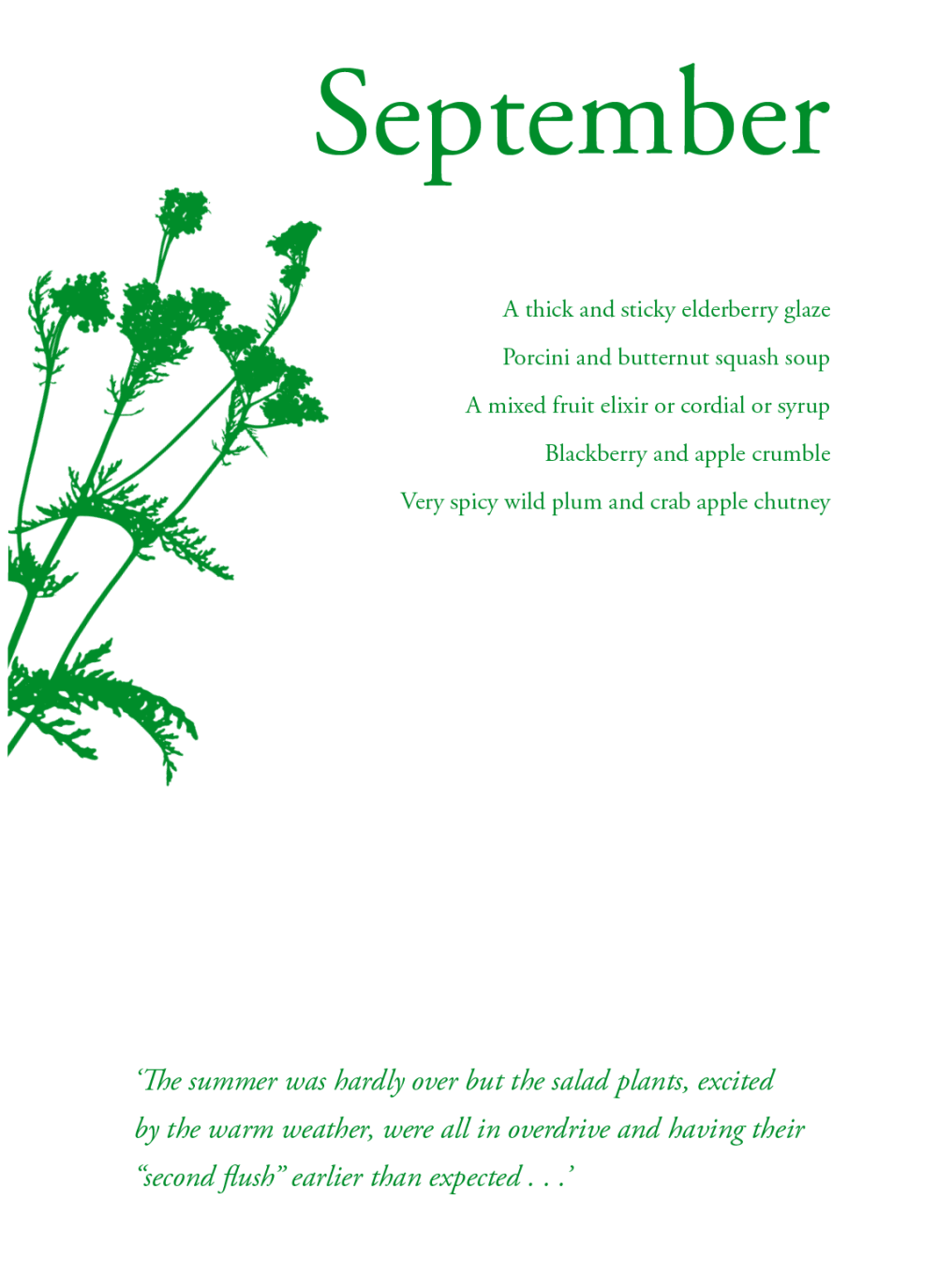
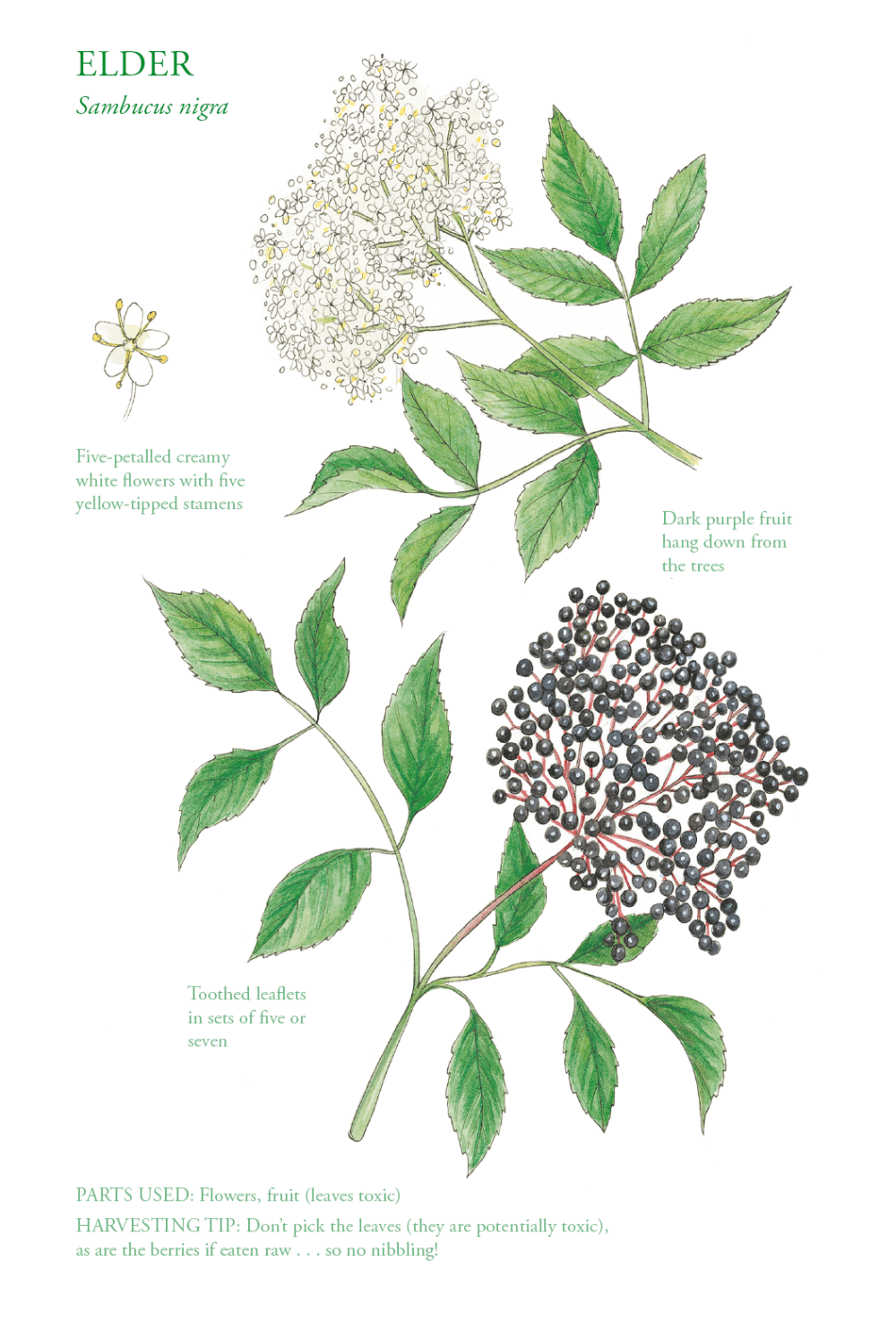
The Edible City – September
5th September. Tottenham
I like to call it ‘green vision’. Once turned on, it’s pretty much impossible to ever turn it off again. Rushing to the Tube is punctuated by flashes of edible plants, just leaving the house turns into an opportunity to lookat potential ingredients, and a walk in a local green space will always be brimming with foraging possibilities and culinary ideas. Sometimes it’s all a bit too much, even for me! In addition to finding ourselves surrounded by wild food, previously irrelevant spots on the city map can become pivotal and much visited, favourite places to return to with each new season. Today I spent a couple of hours in the grounds of a north London hospital, not because I had anyone to visit but due to the amazing array of fruiting trees planted there. Earlier in the year I’d come here to collect edible tree blossoms: heavenly smelling elderflowers, long ‘dangles’ of white false acacia flowers, puffy pink bunches of cherry petalsand delicate light mauve Judas tree blossoms.
My main reason for today’s visit was to look for a true service tree that a friend had mentioned was here, an uncommon and unusual looking tree, with leaves like rowan and fruit like crab apples. I spotted it immediately, near the entrance, then another and another. In total I found sixteen of them, dotted around the grounds and covered in fruit of varying sizes, although still much too early to pick. I resolved to return in about a month by which time these yellow-red fruits should have turned a chocolate brown and become soft and ripe, their taste and texture like a cross between dates and figs.
As always, there were plenty of other things to interest me, most specifically an enormous amount of perfectly ripe dark purple elderberries. Depending on the season and my location, I have picked these from as early as August and as late as December. Or at least I’ve picked them that late twice, but from just one tree that grows very close to my house and seems to have a mind of its own. Armed with a big cloth bag, slung ‘casually’ round my neck, and not wishing to draw too much attention, I set about carefully removing a few bunches from each tree. It always amazes me how many elders there are in the capital; modest and rather dishevelled, they are easy to overlook right up to the point at which they erupt with blossoms in the late spring or early summer, after which they become covered in unripe green berries which I use to make capers. Twenty minutes and probably a hundred goodsized sprays of berries later, my bag was full and my bus was due.
A thick and sticky elderberry glaze
Elderberry wine, elderberry vinegar, elderberry brandy, elderberry jelly, elderberry jam, elderberry cordial, elderberry liqueur . . . Shall I go on? OK . . . elderberry capers, elderberry ice cream, elderberry sorbet, elderberry tincture, elderberry sauce, elderberry tart, elderberry gin, elderberry dye, etc., etc. You get the point, elderberries are very versatile. Not only that, they are nationally abundant, easy to ID and extremely healthy, packed as they are with vitamin C, antioxidants (especially anthocyanins, which give them and numerous other plants their dark purple colour) and other immune ‘modulating’ flavonoids and alkaloids. The only real safety advice I could give would be, don’t eat them raw, they are mildly toxic until they are cooked (or pickled) although reactions vary widely from person to person, some people having no adverse effects and others becoming sick from ingesting just a couple.
700–800g elderberries, 1 litre white wine vinegar, 800g sugar
This simple recipe has been through many hands and seen numerous variations along the way. Family popular on my London foraging walks. Although my version is still very sweet and wonderfully tasty, it uses far less sugar than I have often seen recommended. To create a mixture that will cling like thick syrup to the back of a spoon, you need to up the sugar content, literally doubling the amount I use. This will result in something similar to a balsamic glaze, which is fabulous on meat or fish, but I’d suggest trying the less-sugared version first and then having a bit of a play with different amounts later.
Remove the ripe berries from their stalks by running a fork alongthe stems. Drop them into a big pot of cold water and skim off any that float, then remove all the ripe berries, which will have sunk to the bottom, combining them with the white wine vinegar in a big glass jar. Leave them to sit for about a week, giving the jar a little shake every day or two, then strain the liquid and discard the berries. Put the vinegar, which will now be a rich purple colour, in a saucepan with the sugar and simmer gently for 10 minutes to allow the sugar to totally dissolve before bottling. This will be just thin enough to spray onto food with an atomizer, it makes a delicious salad dressing and goes great with cured meats, roast duck or most freshwater fish. The ‘double sugar’ version will be too thick to spray but can be used in exactly the same way and is the perfect accompaniment to vanilla ice cream. The flavour of this glaze is truly astonishing. I challenge you not to like it!
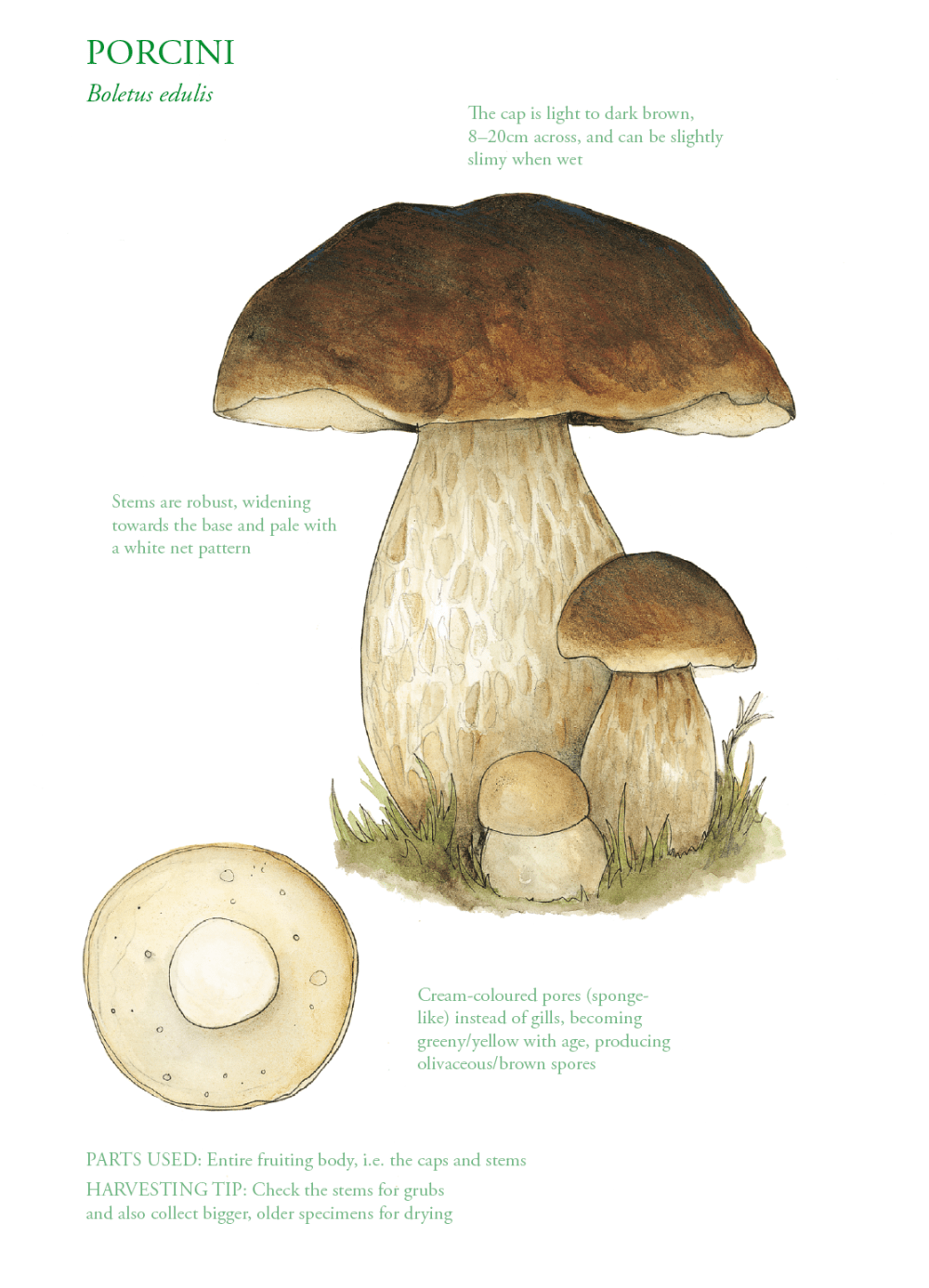
12th September. A forest near Tunbridge Wells
As we stood in the car park, putting on our rucksacks and making sure we had all of our climbing kit for the day, my friend Bryan had a confession to make. ‘John,’ he said, ‘I’ve become a nerd . . . and it’s all your fault.’ We both knew what he was talking about. I had infected him with my enthusiasm for wild mushrooms, always pointing out the different species we’d see en route to Kent’s various climbing areas. Collectively known as Southern Sandstone, these inland cliffs and crags run across most of the county and seem to pop up in the most idyllic woodland locations. Today was no exception, still early in the season (for mushrooms, not for climbing) but numerous varieties were already out. The hike to the crag was only twenty minutes, or at least that would be the journey time for someone not obsessed with what could be found on the forest floor. Surrounded by mature oaks, a few beech trees and plenty of birch and hazel, we set off but only managed a few steps before I stopped. ‘Do you smell that?’ I asked. ‘Stinkhorn!’ This phallic and whiffy fungi (Phallus impudicus, to give its full title) is easier to find with your nose than your eyes. It’s not strictly edible, smelling horrific once it has produced its upright stem and cap, but in the early stages of its growth, the jelly-like egg from which it fruits contains a tiny button mushroom, much prized in Chinese cooking.
We left it untouched, made a couple of obvious jokes and walked on, soon finding something much more interesting, at least in culinary terms. Oh, happy day! A small patch of porcini mushrooms, as the Italians call them, or cep if you’re in France. I like the old English name for this delicious edible species, Penny Bun, which gives a very accurate description of the big brown caps that they are famous for, not that anyone in the UK will have seen a real bun that costs a penny for a hundred years. For just a moment I considered leaving them, picking them on the journey back at the end of the day, but my foraging instincts kicked in and I had no choice. There were only a dozen, varying from about 3 to 6 inches; they would just have to come climbing with us, in case someone else stumbled across them while we were busy on the rock. I showed my friend how to pick them, holding the stem at its base and then twisting until the whole mushroom came free. Carabineers, clips, slings and all manner of otherclimbing paraphernalia got tipped onto the ground; that cloth bag had a more important purpose now. We walked on, two nerds in the woods, arriving at the crag about an hour later than expected.
Porcini and butternut squash soup
There are a million recipes that include this wonderful ingredient, but more often than not I find myself simply frying them with salt and pepper and eating them with as many meals as possible during the season. For porcini in the south of England, this could be just a couple of weeks or as long as three months and occurs anytime frommid-August through to early December. Chefs will always advise adding salt to the frying pan at the last minute, to avoid drying the mushrooms out, but I prefer it added at the start, actually wanting them a little dry and chewy, even verging on crisp, and with their flavour intensified. Gentle cooking will result in a plateful of slugs, lacking in flavour and rather slimy, so don’t be afraid to fry them ‘hard’, although everyone has their own approach so feel free to cook them as much or as little as you like. My favourite way to eat them is just raw, thin-sliced and with a splash of oil and rock salt, a wild fungi carpaccio to make even Carluccio drool. Cep, as the French would say, dry very well and then keep forever. I slice mine 2–3mm thick and either dry them in my dehydrator or spread them out on wire racks and leave them on the stone floor at my mother-in-law’s, where the underfloor heating gradually removes any moisture and the house becomes permeated with an amazing mushroom aroma.
1 butternut squash, 2 tbsp olive oil, butter, 1 large onion, 6 garlic cloves, 2 big handfuls of sliced porcini, about 1 litre good chicken stock, dried herbs, such as wild marjoram, mugwort, sage or thyme, 1 handful dried porcini or mixed dried mushrooms, salt and pepper, soy sauce and cr.me fraiche or cream (optional)
Serves 4–6
This hearty soup recipe requires a whole butternut squash, peeled andchopped into 2.5cm cubes, then parboiled for 5 minutes, just to get it started. Keep the seeds for later. In a big saucepan, heat the olive oil with a big knob of butter and then fry the diced onion and crushe garlic (less if preferred). Now add the fresh sliced porcini and fry for a couple of minutes.
Drain the squash and add it to the pan, stirring for a minute before adding the stock, salt, pepper and a pinch or two of any dried herbs you fancy. Then add a handful of dried porcini or mixed dried mushrooms, which will help supercharge the flavour.
Cook slowly for half an hour, adding extra stock if needed. Put everything into a blender or take a hand blender to the pan. There’s no right or wrong, so it’s up to you how much you blend, how thick the soup is or if you add more stock. At this point I usually add a good slug of soy sauce and, depending on my mood, a couple of tablespoons of creme fraiche or cream. Leave the soup on a very low heat while baking some of the squash seeds (at about 170°∆C) with a little oil. They take about 10 minutes and taste like popcorn. Serve the soup with the toasted seeds sprinkled over the surface.
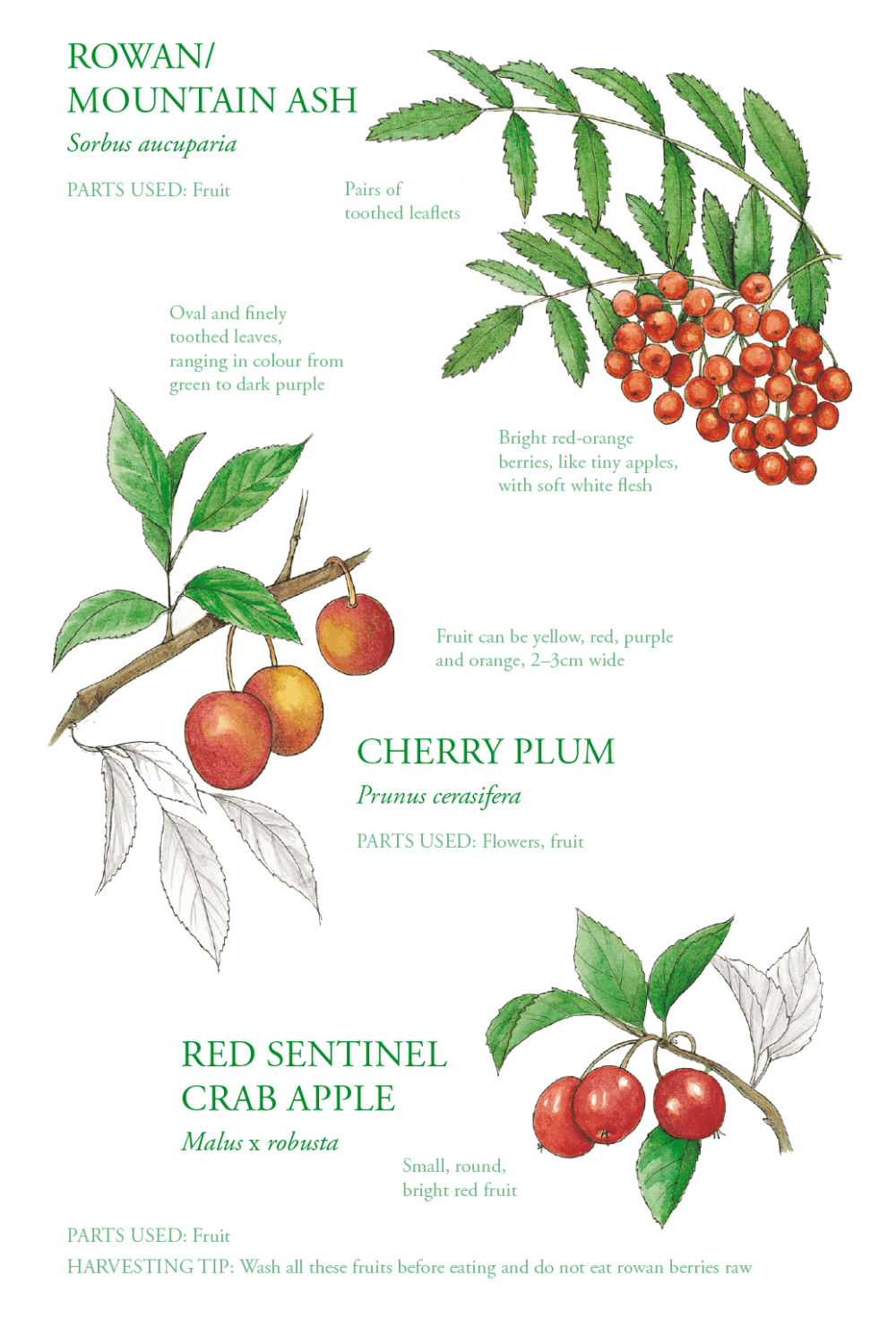
15th September. Haggerston Park
For four years I worked just around the corner from Haggerston Park without ever paying it a visit. At the time, I was more interested in Shoreditch’s warehouse parties and bars than I was in wild food. But today I found myself back in my old neighbourhood, looking for locations for a series of private walks I’d been asked to run near ‘the city’. As I headed to the park, the area looked very much the same as it always had, a bit rough around the edges, with the addition of a few more bars and a couple of swanky hotels. The park itself was something of a revelation, playing host to a staggering array of edible wild plantand trees, all packed into a relatively small space, but today more than anything else I was hunting for berries. It’s a strange form of human arrogance that we assume bright colours in nature are only there for our benefit, either as a warning or an indication that something is particularly tasty. Some of the most beautiful mushrooms are the most deadly (soare some of the drabbest-looking) and some with the most lurid caps and stems are actually tasty edibles. When it comes to tree fruit, strong reds and purples are often (not always) a good indicator of the plentiful presence of beneficial antioxidants, rather than harmful toxins. I spend the winter months scoffing as many of these genuine superfoods as possible, so today I had it in mind to gather as many varieties as I could and then photograph them to promote my autumn walks.
Bordering a shallow pond was a long thicket of tangled branches, small trees entwined with bushes and shrubs, offering a mix of hawthorn berries (haws), sloes, rowan berries and rose hips. I picked just a couple of dozen of each, popping them into my bag, and then wandered to theother side of the park to examine some free-standing trees and relieve them of a few of their fruits. It was too late for the cherry trees and still too early for the cockspur, but three varieties of crab apple made it into the bag, too. I had easily enough for my photograph, but not wanting to waste what I’d picked I began to think of a new mixed berry recipe.
A mixed fruit elixir or cordial or syrup
However you choose to get your fix of berries, and this could be anything from a hawthorn ketchup to a rose hip vinegar or a blueberry compote, you will be getting masses of fibre, vitamin C and phyto-nutrients. Of the 8,000 or so compounds that have evolved to aid and protect the world’s plants, giving them resistance to germs, insects and fungi, many are classified as phyto-nutrients. Although they are enormously beneficial to human health, they are sadly missing from much of our modern food chain. Alas, the presence of these amazing natural medicines has been in decline ever since the advent of Neolithic agriculture 10,000 years ago and generally they have been bred out due to their bitterness. Fortunately they are still abundant and plentiful in wild food.
Last, but by no means least, let’s look at the antioxidants – but what exactly are these mysterious substances anyway? Well, I knew that they were chemicals that inhibited the activity of free radicals, but what in turn are they? In the most basic terms (that’s how I think), they are atoms or molecules with unpaired electrons that make them very reative and, in this new, free state, can cause various types of cell damage and internal wear and tear, making us susceptible to viruses and numerous other conditions, especially as we get older. I asked a knowledgeable friend to explain how antioxidants combat free radicals. Did they prevent molecules splitting in the first place, or form gangs that went around beating up free radicals, or did they encourage free radicals to reunite with their missing partners and thus stop being free, radical and troublesome? Her answer was a few pages long but basically suggested that they did all three . . . I can’t honestly claim to have my head around the science but I wanted to add something by way of research instead of just bandying these terms around without really knowing what they meant.
Mixed fruit (wild and domestic), sugar, 1 cinnamon stick, 2 cloves, 2 or 3 star anise, sugar, honey or xylitol
This is the ideal recipe for any city forager, so take an early autumn wander through your local park or common and come back with just a small handful of any or all of the following berries or fruits: rowan,plum, cherry plum, sloe, hawthorn, medlar, quince, crab apple, pear, rose hip, elderberry, mulberry and blackberry. Supplement what you have with shop-bought plums or soft fruits if you need to. Wash and destalk the smaller ones, chop anything bigger, and put them into a saucepan. With enough water to just cover them, cook for 15–20 minutes with the cinnamon, cloves, star anise and a little sugar, honey or xylitol. Cool and then strain the mix through muslin, squeezing hard to get all the juice out, and then discard the wrung-out fruits. Use as a delicious wild fruit drink, mixed half and half with cold fizzy water, or reheat and add more sweetener to make a cordial – even more and you have a syrup.
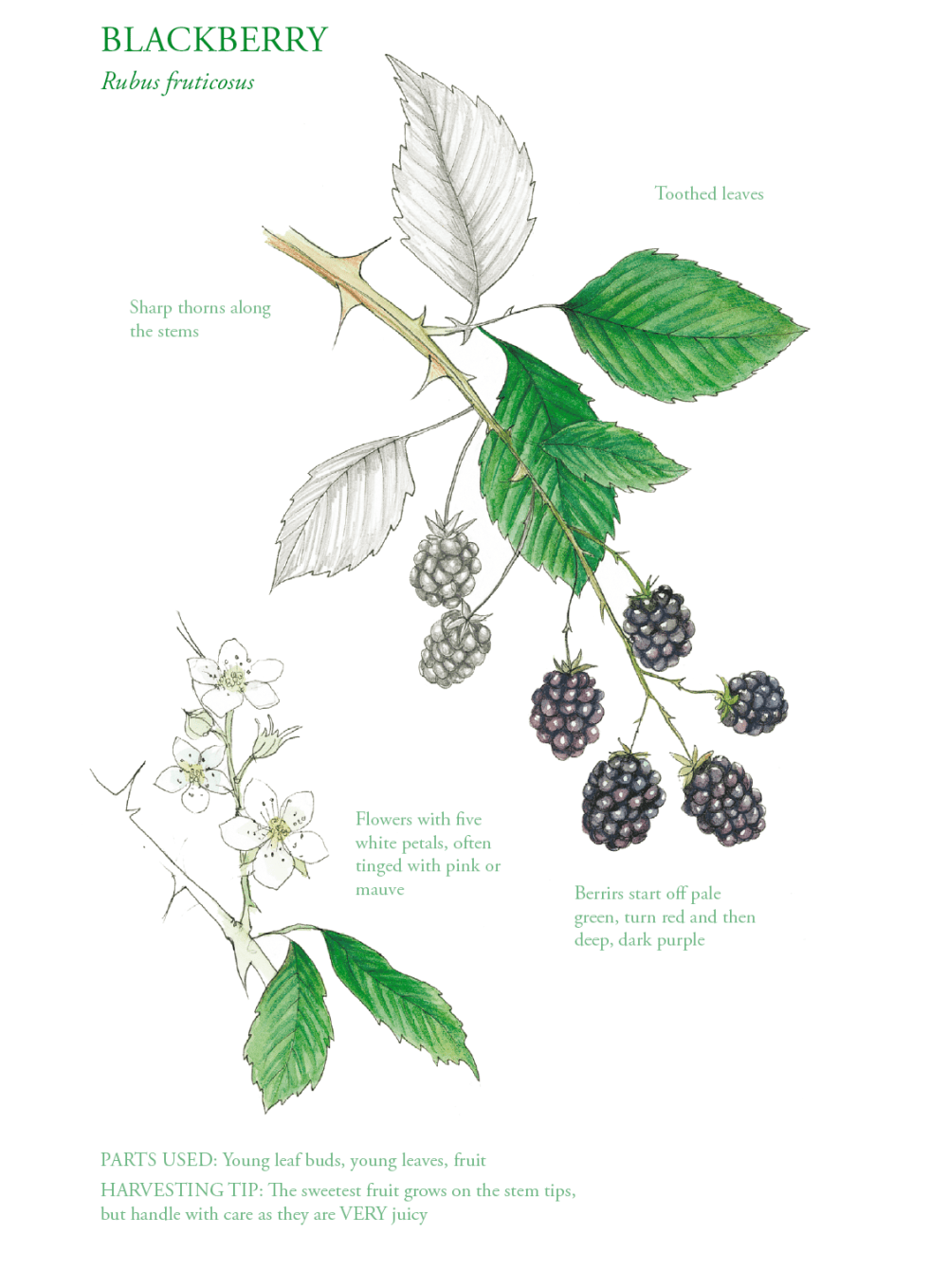
21st September. Lymington Marina, Hampshire
Unlike many people’s relationship with their mother-in-law, I am extremely fond of mine, so staying at her house on the south coast is always a pleasure. She has a huge pond-cum-paddling pool for Oscar and me to play in and, best of all, porcini mushrooms growing around an old oak tree in her back garden. These are one of my fungi early warning systems and when I hear they are popping up, often as early as mid-August, it’s time for me to jump in the car and head to the forest to see what else is happening. Today, when Oscar suggested we go foraging (sweet music to my ears), I knew immediately what he was thinking about, and it wasn’t mushrooms. I have never seen a child, or adult, so totally obsessed with blackberries and, fortunately, the coastal path that backs onto the bottom of his grandma’s garden is bordered by an almost endless hedge of brambles. When it comes to our 340 species of UK bramble, I’m far from being an expert; in fact were I to be a plant nerd of such epic proportions I would be called a batologist (a botanist who specifically studies this one genus). I can distinguish between a few of the more obvious varieties, but have no real reason to go into greater depth and, more importantly, no spare time for such specifics.
Leaving the house with a little one in tow is never a speedy task but after much faffing and looking for lost wellies we all set off together, the adults taking in the views across the Solent, the Isle of Wight clearly visible on the other side of the water, enjoying the warm September weather that so often these days puts August to shame. Oscar was already focused on the task in hand, a massive grin on his face and a chin dripping with dark juice. I tried to explain that the sweetest berries were the ones on the stem tips and that they’d had the longest time to ripen and produce sugars, but he wasn’t listening. Using a rough ratio of three in the mouth to one in the basket, he was surprisingly adept at blackberry picking for a three-year-old, carefully removing the lowest hanging of the ripe fruit and somehow managing to not scratch himself on their thorny armour. We all joined in and our basket began to fill up, although Oscar then abandoned picking any himself, seeming very pleased that everyone else was there to feed his addiction. Telling him I thought he’d had enough for now, I began to carry the basket out of his reach. Tears flowed, small feet were stomped, we ground to a halt and eventually a truce was reached, me carrying both him and the basket, feeding him the odd berry for the rest of the walk. Later I returned for some solo foraging and was able to collect a few hundred without having to trade every third one for a quieter life.
Blackberry and apple crumble
Like elderberries, the list of uses for blackberries is endless. Unlike elderberries, and as everyone knows, blackberries can be eaten raw and it’s not easy to beat the pleasure of munching fresh wild berries and fruits straight off the tree or bush they’re growing on. The very young unopened leaf buds that appear near me around late February taste like tiny mushrooms, providing you get the timing right; a little too late and they are extremely drying on the mouth or, as my Scottish friends would say, ‘It’s like licking piss off a thistle’! When the leaves have opened and are bright green, they make one of the best herbal teas and I have also heard of people candying the young stems and then cutting them into thin slices to produce star-shaped sweets. I like to add ripe blackberries to cider vinegar and leave them for a couple of weeks to impart their wonderful flavour and rich colour but my favourite use is in a blackberry and apple crumble, English comfort food at its best.
For the filling: butter, 500g Cox’s or Bramley apples, 300g blackberries, 100g brown sugar, powdered cinnamon, 2cm square of ginger root, creme de cassis (also try cherry brandy or whatever sweet liqueur you have.
For the topping: 100g butter, 300g plain flour, 100g brown sugar, 50–70g granola
Serves 6–8
I think this was originally my mum’s recipe but I have made it so many times that it has become somewhat bent out of shape. As with all my cooking, I find it almost impossible to stick to the recipe, but here goes!
Set the oven to 200°∆C/gas 6 and then grease a big ovenproof dish with butter. Peel, core and chop the apples, preferably a tart variety, and add these to the dish with the blackberries, then cover with the brown sugar. Add a pinch or two of powdered cinnamon, grate the root gingerover the top and drizzle on a little creme de cassis. This I started using because there was a bottle lurking in my cupboard but it could have as easily been something else, cherry brandy, a sweet vinegar or another neglected liqueur.
For the topping, mix the diced butter, plain flour, brown sugar and granola, rubbing it all together until it becomes . . . crumbly. Spoon it evenly all over the fruit and add more drizzles of cr.me de cassis for good measure. Bake for about 45 minutes and serve with creme fraiche, double cream or, my top choice, vanilla custard.
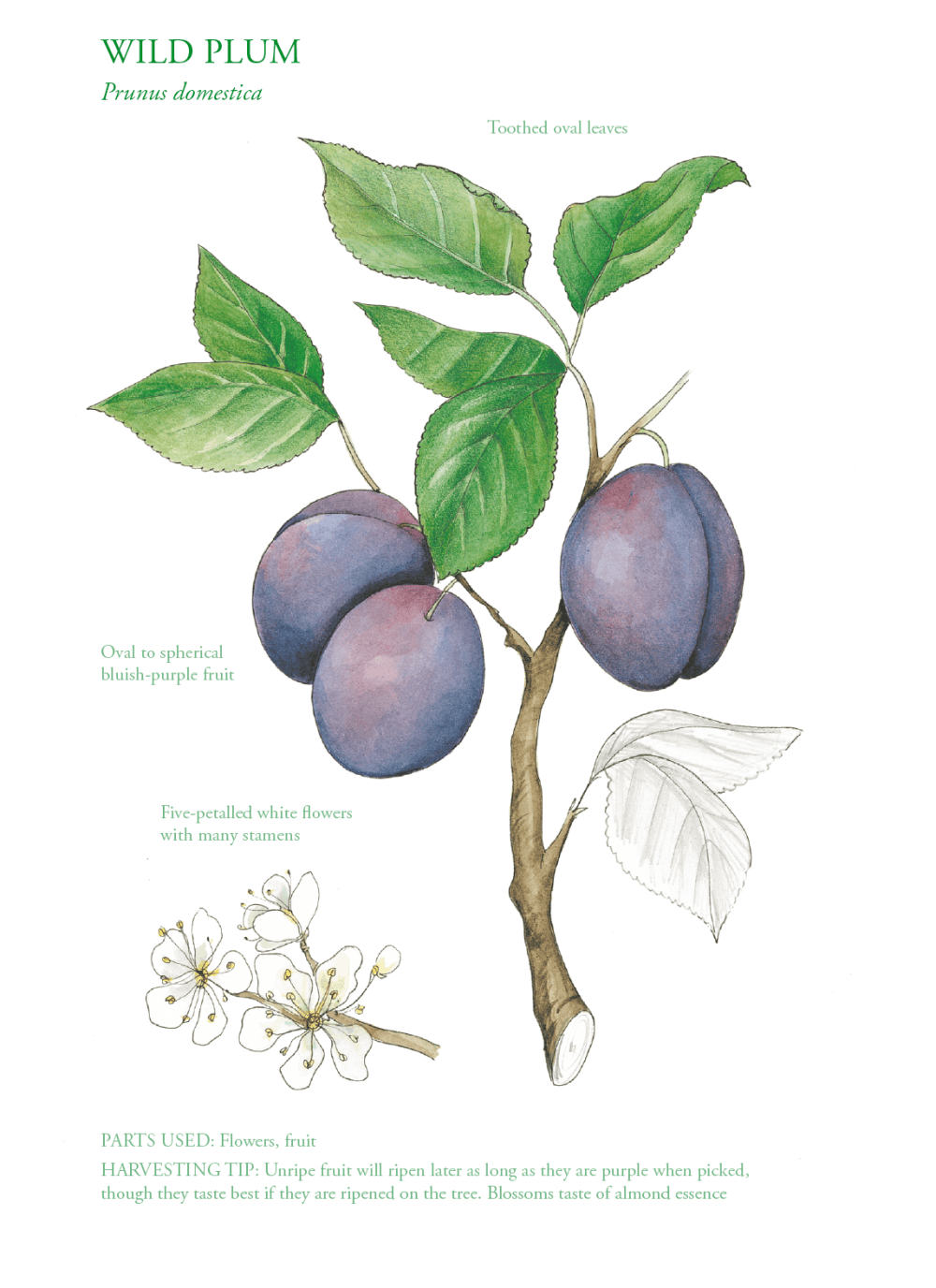
24th September. Tower Hamlets
Although foragers like to think of themselves as adventurous, they are actually creatures of habit and tend to return to the same places repeatedly throughout the year, never straying that far from home for fear that they’ll miss something. I once left London for a few days just before my much-loved lime blossoms came out, only to find that on the south coast they were nowhere near ready and by the time I returned to the city they had come and gone. Damn, another whole year to wait for them to come again! Today I visited one of my regular spots, an old cemetery turned nature reserve and a place that I genuinely believe to be the most fertile and diverse square mile in this entire city, if not the whole country. The summer was hardly over but the salad plants, excited by the warm weather, were all in overdrive and having their ‘second flush’ earlier than expected. At a glance, I could see three varieties of wild mustard, all still in flower (or had they decided to flower again? . . . it’s hard to tell these days). A big patch of green in front of me was made up entirely of edible members of the daisy family, sow thistle, wall lettuce, dandelion, nipplewort, ox-eye daisy and scented mayweed (or maybe it was chamomile, it was September after all, not May). There were even a few clumps of late-flowering wild rocket, intensely peppery, as I discovered by munching on a bunch of leaves while I collected some of the other salad ingredients.
Looking to the trees, I noticed that the hawthorn was having an amazing year, huge bunches of red haws hanging from every branch, the sloes (blackthorn) by comparison looked pretty thin on the ground. I wandered, I do a lot of that, you know, and was happy to find that a couple of ‘my’ favourite wild trees, damsons to be more specific, were covered in fat juicy plums. I think my earliest foraging memory is of plum picking in a friend’s garden, using a similar ratio to the one my son applied to his blackberry foraging . . . one for the bag, two for the mouth. I do remember that the end result was a very sore stomach and a stern warning from my mum. Today I would be less greedy and I needed a good bagful for the recipe I had in mind. I’d two-thirds filled my bag before a crab apple tree came into view and I knew that I’d need to pick a few dozen of these, too. As happens to me so often, the recipe had invented, or at least modified, itself to suit what was in season.
Very spicy wild plum and crab apple chutney
1.5kg wild plums, apples and crab apples (that’s 1.5kg after removing the unwanted bits, not before), 4 medium shop-bought plums, preferably thered ones, 2 peppers, 500g fresh tomatoes, 8–10 garlic cloves, 4–6 medium hot green chillies including seeds, 250g red raisins or similar, 250g golden sultanas, 250g black raisins, a big handful of dried white mulberries (optional), 15 cloves, 2 tsp salt, 2 tsp fresh ground pepper, 2 tsp cayenne pepper, 4 tsp star anise (need to be ground up first), 2 tsp dried chilli flakes or similar, 2 tsp ground cinnamon, 2 tsp paprika, 0.5 tsp smoked paprika, 2 tsp ground coriander, 1.2 litres vinegar (just the cheap stuff), 400–500g brown sugar
This is a big list of ingredients but you can change it around depending on what you have available, miss things out and add others, supplementing the recipe with whatever seasonal fruits you have to hand. Also, you can decide how finely to chop the ingredients depending how smooth or rough you want the final chutney to be. Either way, this is a super-spicy condiment and everyone who tastes it demands the recipe – everyone that is except my mum, whose idea of too spicy is a mild chicken korma. It was previously known as John’s Hardcore Winter Chutney and I’d give it away to people at Christmas in jars labelled with a picture of Santa doing something quite obscene. Each time I make this I change the recipe and generally make it spicier than the previous time, but perhaps on your first go, split the batch in two and try making one half as spicy and one half less spicy than my version. I have a tendency to make industrial-sized quantities of this chutney, generally three to four times the amount described here, and I am often asked when I will be making another batch. I always use this request as a chance to enlist the services of the person asking, to help with the endless chopping, and should you find yourself in the samesituation, I recommend you do likewise.
Core and stone the plums, apples and crab apples. Chop them into small pieces along with the peppers, tomatoes, garlic and chillies and put all the ingredients except the vinegar and sugar into a big (and I mean big) pan to cook gently for 30–40 minutes, adding about 120ml water if needed. Then add half the vinegar and simmer for a few minutes until the apples are cooked properly, then add the rest and all the sugar. Give everything a good stir, cover the pan and leave it to simmer gently foraround 2 hours. Leave to cool and store in sterilized jars. Job done.
